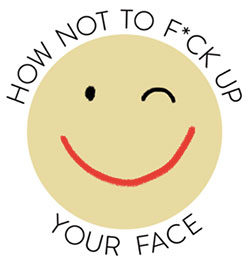
By Valerie Monroe
If you’re interested in feeling happier about your appearance—especially as you age—you might like reading what she has to say about it. For more of her philosophical and practical advice, subscribe for free to How Not to F*ck Up Your Face at valeriemonroe.substack.com.

Can’t get enough Valerie Monroe? There’s more at https://valeriemonroe.substack.com.
ASK VAL answers your urgent questions, Vol. 32.
Yes, you with a handful of—are those mascara wands?
Q: I have short, sparse lashes and yearn for thicker, longer ones. A lot of lash serums claim to help with that, but I’m not convinced they really work. If you were to recommend one (preferably a drugstore serum), which would it be?
A: Of course you yearn for thicker, longer lashes; a set of lush eyelashes, doing the necessary job of protecting our eyes from dust and debris, can be a signal of good health and (as it sometimes follows) even a fine choice of reproductive partner, if you’re into that.
It’s times like these I’m glad to be able to rely on professional advice. I tried a lash serum once. The results were . . . well, you can read about them here. So I turned to HNTFUYF DermDiva Heidi Waldorf, who had some helpful thoughts.
First, a brief explanation of how a lash serum works, because we don’t like to slap stuff on our face—especially around our eyes—without understanding what it’s going to do, do we? To increase lash length, you need to prolong the active (anagen) growth period when the hair follicle isn’t resting or when the hair is falling out. Prostoglandins (a.k.a. fatty acid compounds) do exactly that—and it’s the prostoglandins in the prescription formula Latisse that can lengthen, darken, and thicken lashes when applied to the lash line consistently. (Benefits stop if you discontinue use.)
For some users, Latisse can cause irritation, reddening, or pigmentation of the eyelids, as well as atrophy (reduction) of eyelid fat, most of which is reversible if you stop using it. (But . . . geez.) Pigmentation—as a brown spot—in the iris of light brown or hazel eyes is also a rare but irreversible complication. A less-concerning side-effect—and a weird one to which I can attest—is lashes (or, in my case, eyebrows) that grow in at strange angles or with a different texture (curly instead of straight).
Anyway, Latisse is pricey (upwards of $100 for the name brand) and you asked for a drugstore product recommendation. As you say, there are a lot of serums out there, some of which contain prostoglandin analogues (similar to the compound in Latisse) that make alluring promises. The two Waldorf recommends are Nulastin and Revitalash. Waldorf uses Nulastin—both the lash and eyebrow formulations—with excellent results, she says. Revitalash is less drippy and easier to apply. I’ve tried neither, but I’d go with the Nulastin for a couple of months. If I saw no difference in my lashes, I’d take this aesthetic aspiration off my plate and revert to my favorite mascara.
If you do choose to pump up your lash volume, Waldorf has some rules about how to use any serum:
- Don’t apply more product than recommended
- Apply only above the upper lash line
- Apply once a day before sleep, when the product will also benefit lower lashes
- After application, blot excess on the surrounding skin and under lashes to avoid any serum getting into your eyes. Blinking on a folded tissue works well.
Are you wondering about the fake lashes you can have a technician apply in a lash salon? Waldorf thinks they’re fine for a big event (your Presidential Inauguration, for example) but doesn’t recommend continuous use. Even if they’re gently applied, she says, their weight on your real lashes can be traumatic and cause traction alopecia (like what can happen when scalp hair is consistently pulled too tight). She also cautions that you do a patch test to be sure you have no allergies to adhesive.
◊◊◊◊◊◊◊◊◊◊
I’m still posting from Tokyo, where my son and daughter-in-law and delightful little granddaughter live. So another observation from this side of the world: A small recent study in Japan showed that when people are asked to donate money, they’re more likely to do so when they feel they’re being watched. Adding a pair of eyes to a sign requesting donations generated greater compliance. Which is why I wasn’t surprised recently to see the sign below at a playground. It seems a little creepy; on the other hand, if it works, why not?

And among the many fun names of hair salons in Tokyo, this is one of my favorites.


I found Valerie Monroe’s advice on aging and beauty to be insightful and practical. It’s refreshing to hear a perspective that emphasizes self-acceptance and self-care over chasing unattainable beauty standards. As someone who struggles with short and sparse lashes, I’m intrigued by the mention of lash serums. However, with so many products on the market, it’s hard to know which ones actually work. So, my question is: have any readers had success with lash serums, and which ones would you recommend?
Well, in Val’s column, dermatologist Heidi Waldorf recommends Nulastin, which she herself uses. None of them–Latisse, Revitalash, Nulastin–is cheap, for sure.
I have gotten my eyelashes dyed twice and if I could find a reputable place closer than the salon in New Jersey where my daughter lives I would do more often. I have been really satisfied with this for $35. my eyelashes are fine but wearing mascara gets on my eyeglasses and is a bother. I prefer this to the fake eyelashes. Not sure why I have pretty thick lashes for my age but I am grateful